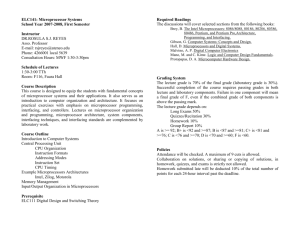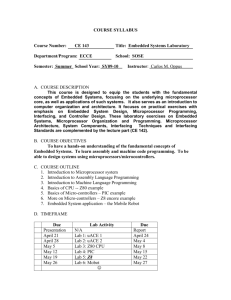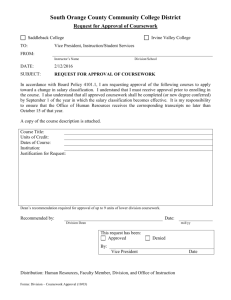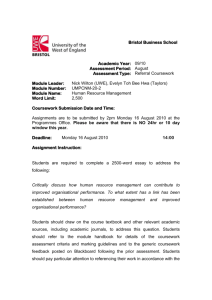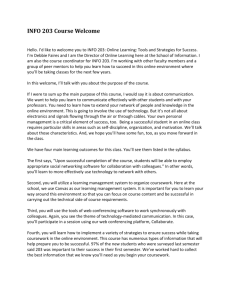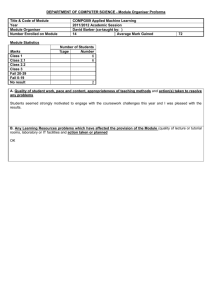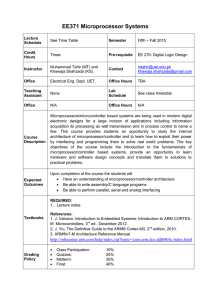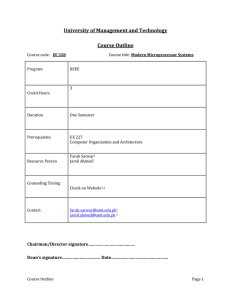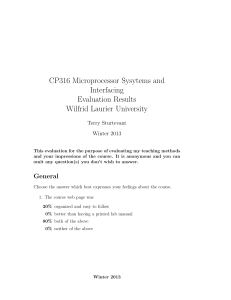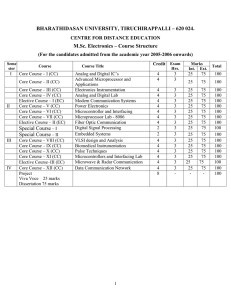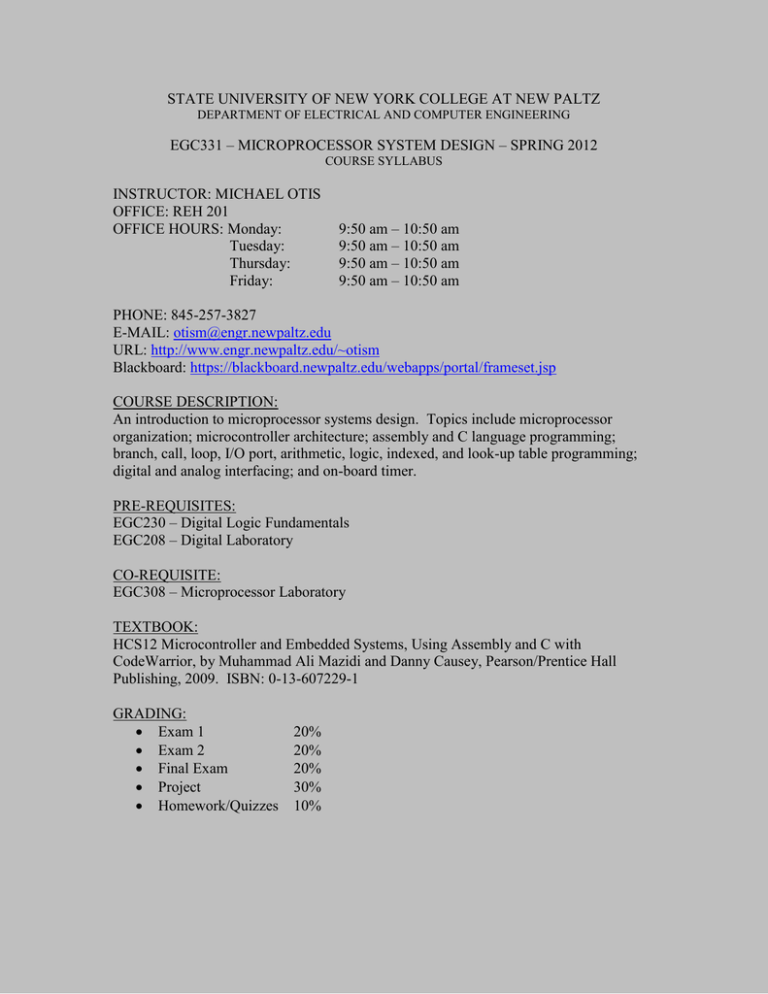
STATE UNIVERSITY OF NEW YORK COLLEGE AT NEW PALTZ
DEPARTMENT OF ELECTRICAL AND COMPUTER ENGINEERING
EGC331 – MICROPROCESSOR SYSTEM DESIGN – SPRING 2012
COURSE SYLLABUS
INSTRUCTOR: MICHAEL OTIS
OFFICE: REH 201
OFFICE HOURS: Monday:
Tuesday:
Thursday:
Friday:
9:50 am – 10:50 am
9:50 am – 10:50 am
9:50 am – 10:50 am
9:50 am – 10:50 am
PHONE: 845-257-3827
E-MAIL: otism@engr.newpaltz.edu
URL: http://www.engr.newpaltz.edu/~otism
Blackboard: https://blackboard.newpaltz.edu/webapps/portal/frameset.jsp
COURSE DESCRIPTION:
An introduction to microprocessor systems design. Topics include microprocessor
organization; microcontroller architecture; assembly and C language programming;
branch, call, loop, I/O port, arithmetic, logic, indexed, and look-up table programming;
digital and analog interfacing; and on-board timer.
PRE-REQUISITES:
EGC230 – Digital Logic Fundamentals
EGC208 – Digital Laboratory
CO-REQUISITE:
EGC308 – Microprocessor Laboratory
TEXTBOOK:
HCS12 Microcontroller and Embedded Systems, Using Assembly and C with
CodeWarrior, by Muhammad Ali Mazidi and Danny Causey, Pearson/Prentice Hall
Publishing, 2009. ISBN: 0-13-607229-1
GRADING:
Exam 1
Exam 2
Final Exam
Project
Homework/Quizzes
20%
20%
20%
30%
10%
COURSE OUTLINE:
1. Intro to Computing.
Microprocessor organization. Memory and I/O interfacing.
2. HCS12 Architecture.
System architecture. Memory map. Addressing modes. Condition Code Register
(flags.)
3. Assembly Language Programming.
Data format and directives. Stack and data transfer. Branch and loop, and jump and
call instructions. Indexed addressing.
4. ‘C’ Programming.
Data types. Time delays.
5. I/O Port Programming.
Interfacing and I/O bit manipulation.
6. Arithmetic and Logic Operations.
Arithmetic, logic, compare, rotate, and shift instructions. Signed numbers.
7. Advanced Assembly Techniques.
Advanced indexed addressing modes. Look-up tables.
8. Interfacing.
LCD and keypad interfacing.
10. Analog-to-Digital Conversion.
Simple non-interrupt based Analog-to-Digital Conversion. Variable analog voltage
measurement.
11. Timer.
Simple non-interrupt based Output Compare and Input Capture. DC Motor RPM
measurement.
12. Pulse Width Modulation.
Simple non-interrupt based Pulse Width Modulation. DC Motor speed control.
COURSE PROJECT:
Using a hierarchical approach and Freescale’s Codewarrior and Evaluation Board, design
and verify (through simulation and implementation) a microprocessor-based motor
instrumentation and control system.
POLICIES:
ADA Policy: If you have documented disabilities, inform the instructor privately
during the first week of class and make proper arrangements. Refer to the Student
Handbook for SUNY New Paltz policies.
Attendance: You are expected to attend lectures on a regular basis. In case of
absence, it is your responsibility to obtain notes from your fellow classmates, not
from the instructor.
Missed Coursework: All coursework is your responsibility. There are no
excuses for handing in coursework late. Coursework will be graded as late if not
handed in on the due time/date, which is at the beginning of the class period on
the due date. Coursework will be penalized one letter grade each day it is late.
Rescheduling: There is no rescheduling unless emergencies arise related to
medical or family matters. Rescheduling is contingent on the student presenting
both documentation describing the reason(s) for the absence and contact
information for the person providing the document(s).
Plagiarism: Submitting material that is not your own work, including internet
materials, is considered plagiarism, and will result in a failing mark and a report
to the department chair and dean. Quoted material must be correctly cited. Refer
to the Student Handbook section on Academic Integrity for a full discussion of
policies on plagiarism, cheating, and forgery.

